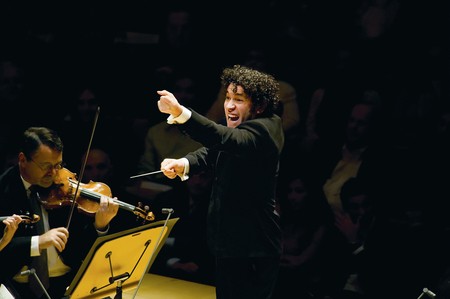Gustavo Dudamel is an anomaly among symphony conductors, particularly those who have worn the mantle of greatness. Ferocity, transport, mighty jubilation, and above all else, gravitas have etched the lines on the imposing brows of the great Olympians. So what shall we do with Gustavo, who on the inaugural nationwide LA Phil LIVE broadcast struggled with the English language, self-mockingly fussed over his hair backstage before entering Walt Disney Concert Hall, and impishly covered the camera lens?

- Courtesy of Los Angeles Philharmonic Association
I say enjoy his impish spontaneity if you can, for Dudamel makes even the late telegenic Lenny Bernstein seem donnish and histrionic by comparison. When hostess Vanessa Williams (a very Hollywood choice) asked questions about the music we were about to hear – including Bernstein’s Jeremiah Symphony and Beethoven’s Seventh – Dudamel appeared disarmed and vivaciously unrehearsed. Bernstein, who gave us the impression of palling around with Ludwig during his free time, would have answered with nonchalant authority in resonant words that would have seemed chiseled, letter by letter, on Sinai.
Compared to the Met Live in HD broadcasts, now polished gems in their fourth season, the LA Phil’s debut looked scrappy at times from a video standpoint. The same camera that brought us Dudamel from off at the right stereo channel when he was onstage seemed to back up into the wings for the cramped prelude and live intermission segments. A Bernstein or a James Levine might not have been so playful had they been afflicted with such a nuisance.
But the pre-filmed segments were as admirably polished as the Met’s, and the sound engineering soundly trounced the Met’s right out of the box. I’d never noticed before that the six speakers that hang on the walls of Theater 10 at the Stonecrest 22 were actually Klipsch loudspeakers. That’s because the sound from the Met HD broadcasts has never been good enough to make me curious.
The striking Disney Hall, boldly designed by Frank Gehry to accommodate the LA Phil in an arena setting, seats the orchestra onstage, where even the modernistic music stands look like they’re part of the acoustic scheme, yielding a sound palette that is fresh and clear. At beautiful Lincoln Center, the Met orchestra performs in more traditional circumstances, in front of a proscenium and buried below the stage. Big disadvantages for sound engineers.
Yet the sonic superiority of the LA Phil may nudge the Met in the direction of raising its game. Not that everything on the Left Coast was comfy and perfect. The sound imaging of the LA Phil was exactly the opposite of what you’d expect. Instead of the usual panorama, facing the orchestra over the conductor’s shoulders, the stereo perspective had us facing Dudamel over the musicians’ shoulders. Balances, particularly when the French horns and bassoons were called upon, instantly betrayed studio intervention and doctoring.
Took some getting used to, but when there are huge numbers of audience seats all around the orchestra, including behind the musicians facing their leader, that perspective is as valid as any another. No POV can be consistently life-like when the camera crew is perpetually shifting their views from close-ups of the principal musicians to close-ups of Dudamel. And wouldn’t it be a huge improvement if the sound quality at Met broadcasts were clear and crisp enough to quibble passionately over balances and stereo imaging?
Before they played his “Slonimsky’s Earbox” to start the concert, John Adams compared the LA Phil to a Ferrari, a machine one craves to stretch to its limits. The rich details and dynamics that Dudamel coaxed out of the Phil throughout the concert certainly underscored Adams’ characterization. But a couple of times during the evening, we were fortunate that the music triumphed over Dudamel’s verbal descriptions.
In the Bernstein, the opening “Prophecy” movement was a desolate lament, gradually rising to Mahler-like grandeur and epic terror. Unlike Dudamel’s description of the middle movement, leading us to expect a merry maypole frolic, “Profanation” had a raw, raucous festivity to it with a rich, melting-pot expansiveness – and danger – that prefigured West Side Story. As for mezzo-soprano Kelley O’Connor’s vocal work in the concluding “Lamentation,” I can commend the purity of her tone, but her Hebrew was barely accurate enough to confirm that these were the passages from Lamentations that begin the Scriptural reading on Tisha B’Av, the fast day commemorating the destruction of Jerusalem’s Holy Temple. The approximation of emotion was in the same class.
There was a similar disconnect between Dudamel’s description of Beethoven’s somber allegretto and the actual performance. Gustavo would have us believe that the sorrows here were primly internalized instead of inconsolably gushing forth. Yet the slightly accelerated tempo applied to the allegretto didn’t diminish the grieving so much as it excited the urgency of its expression.
Bernstein might have heroically projected elegiac suffering from the podium if he were on the large screen conducting this music in HD. Yet I suspect he would agree that no matter how deeply aggrieved Beethoven can sound, joy is forever immanent at the heart of his work. Here is where there is concord between Lenny and Gustavo. Looking at the faces of the musicians of the LA Phil, I detected additional kinship in the enthusiasm that their musical director has injected into their playing.
They are mirroring the best of their leader.
